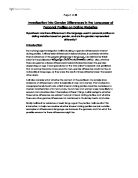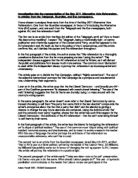- fillers
- reformulation/recycling
- monitoring devices
- politeness techniques
- convergence
- tag questions
- turn-taking
- pauses
- second person/third person voice
- passive voice
- minimal response
- self-repair
Limitations of the investigation
- Small sample size: it would be more accurate if there were more groups sampled (not larger groups, as the participants would have fewer opportunities to speak)
- Sometimes the participants needed prompting which of course distorts the course of the conversation, and some groups needed more prompting than others, which leads to less valid results
- Always the Observer’s Paradox: when teenagers especially are being observed, their behaviour and speech patterns alter
- A problem-solving activity would therefore be better than a discussion, because they would soon forget about the tape recorder while trying to solve the problem
- The discussions were not timed and so there is an unequal representation of each group
- Girls more likely to show agreement with others:
Girl: I suppose it changes as you get older
Girl 2: [yeah]
Girl 3: [you’re right]
Supports Fishman’s findings that women are more likely to use supportive minimal responses to show interest/agreement than men; supports Tannen’s findings that women prefer to establish a rapport within the group and encourage co-operation rather than opposition.
- Girls more hesitant about their opinions, more likely to backtrack:
Girl: if girls know that boys think that she’s fit they’re more likely to be stuck-up rather than like (.) pretty girls (2) maybe (1) maybe that’s a bit stereotypical (1) but
Girl: yeah but (.) some girls to be fair do say “oh I’m not pretty”
Supports Lokoff’s findings that women are more likely to hedge their opinions to soften a potentially harsh tone and gain approval from the group.
Boy: well in my opinion lots of girls wanna look [inaudible] and they think they gotta lose weight and gotta buy new clothes and stuff
Supports Tannen’s theory that men prefer independence from the group, as highlighted by the first person construction used here.
- Boys interrupt the girls more
Boy: …and they’re just looking for someone to say, “no you’re not, you’re beautiful”
Straightforward style of speech supports Fishman’s findings that men do not employ as many attention-getters to change topic, as well as Tannen’s belief that men prefer to report and lecture than to listen and establish rapport.
Conclusion- both boys and girls displayed more stereotypically male or female speech traits in accordance with famous research when with the opposite gender
6 boys
When in an all-boys group, typical “female” traits were more apparent:
- Boys playing for time with hedgers
Boy: hmm (1) I’m not really sure
- Boys support each other with agreement features; are also more hesitant, use monitoring devices, less forceful with opinions
Boy: well yeah (.) it varies I guess (.) some people (1) are obviously [more picky]
Boy 2: [they’re just trying to get some]
All: [laughter]
Boy 3: fair point actually
Boy: I suppose it’s seen that (.) like (.) girls spend more time on their looks (.) so maybe (.) that could make (.) boys more picky
Boy 2: yeah (2) what [name] said pretty much
Boy 3: [yeah]
Boy 4: [yeah]
More pauses, third person is used a lot more when discussing opinions. Hedgers such as “I guess” and “I suppose” soften the certainty of expressing a viewpoint, making it more acceptable to the group.
Boy: I’m not sure (.) it can vary a lot (.) depending on the person really
Boy 4: [inaudible]
Boy 3: I’d say probably yeah (.) because girls spend more time on their looks (2) so it probably means guys do are more picky (1) if you get what I mean
Boy: well no that’s a good point (2) I dunno I just think [maybe]
Boy 2: [stop hogging the floor]
Monitoring devices are used much more frequently, and even more softening of opinions is done. Agreement establishes a rapport, at odds with Tannen’s theory that men are oppositional and confrontational.
-
Conclusion- boys exhibit more stereotypically female speech traits and seem more anxious for approval when with their own gender (face theory)
6 girls
- Girls support each other verbally
Girl: definitely
Others: [laughter]
Girl 2: I definitely am
Girl 3: I think like (.) some guys properly think [inaudible]
Girl: [yeah]
Girl 2: [yeah]
Girl 4: [yeah]
Girl 2: …they will make a comment about her what she looks like like “oh she’s got a big”
Others: [yeah]
Others: [laughter]
Girl 5: [yeah but]
Girl 3: [yeah]
Girl 6: ours think we go for (.) like if you think about it we go for um more boys faces whereas (2) like [inaudible] boobs
Girl: [yeah]
Others: [laughter]
Girl 3: yeah like (1) look at the tits on that
Others: [laughter]
Girl 2: [no but ] I think it’s pretty equal
Can be suggested that the use of fillers such as “like” and “um” is due to idiolect rather than hesitancy. The support and rapport still remains the same.
- Interruption/overlap is very frequent but seems to enrich the conversation rather than detracting from it or creating confrontation
Girl 3: friends with benefits guys
Girl 6: [laughter]
Girl 5: [no way]
Girl 4: [no]
Others: [laughter]
Girl: [you]
Girl 6: [that’s like you kissing [name]]
Others: [laughter]
Girl: [that’s disgusting]
Girl 5: [and my [inaudible]]
Girl 2: and the conversation gets really awkward
Others: [laughter]
Girl 2: I suppose we
Girl 6: [and now you think]
Girl: [and guys]
Girl 2: and now you said that (.) I was just
Girl 5: [see like her little comment just]
Girl: [and always like]
Girl 2: [literally]
Girl 3: [joking]
Girl: [yeah let’s just get back to whether girls are more picky than boys]
Girl 3: [laughter]
Girl 6: yeah we changed topic
- Girls use fewer monitoring devices and hedgers here: they are not afraid to contradict each other, and it is not seen as negative when they do so: they do not feel the need to seek approval from others
- Girls also went off on random tangents involving Glee and Hannah Montana
Conclusion- girls do not feel the need to seek approval when only with their own gender: their hesitancy disappears and they are less afraid of moving away from the established opinion







